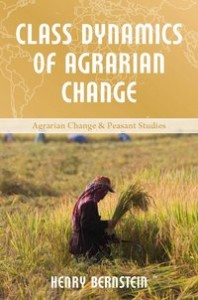 Bernstein, Henry. 2010. Class Dynamics of Agrarian Change. Hartford, CT: Kumarian Press
Bernstein, Henry. 2010. Class Dynamics of Agrarian Change. Hartford, CT: Kumarian Press
Drawing from the Journal of Agrarian Change, Henry Bernstein defines agrarian political economy as investigating “the social relations and dynamics of production and reproduction, property and power in agrarian formations and their processes of change, both historical and contemporary” (1). Bernstein is interested specifically in the class dynamics of these changes and processes, so he delves immediately into class differentiation in the countryside—mainly, among the rural poor. The book gives an excellent and sweeping overview of these class dynamics over a broad historical period.
“As a result of class formation there is no single ‘class’ of ‘peasants’ or ‘family farmers’ but rather differentiated classes of small-scale capitalist farmers, relatively successful petty commodity producers and wage labour” (4). Bernstein makes the claim that even peasants almost exclusively engaged in subsistence farming are not outside the dynamics of capitalism: “the extent to which ‘small farmers’ can satisfy their food needs from their own production is shaped by the ways they are integrated in commodity relations” (104). This is at least partly explained by the fact that small farmers are normally engaged to some extent in subsistence-oriented production, petty commodity production, and wage labor.
Throughout the book, Bernstein shows how “social relations of property shape social divisions of labour, which shape social distributions of income, which in turn shape the uses of the social product for consumption and reproduction—which, in the case of capitalism, includes accumulation” (24). He uses the notion of the “commodification of subsistence” (from Robert Brenner) to highlight how small farmers might lose their ability to produce for their own livelihoods without being fully dispossessed of their land. This approach, he says, “may provide a more generic basis of the subsumption of labour by capital than the outright dispossession usually suggested by notions of ‘proletarianization’” (34).
In terms of differentiation and the persistence of the peasantry, his analysis fits well within the work I’ve written about by Lenin and Chayanov. Though not dismissing primitive accumulation as an immanent dynamic of capitalism, the commodification of subsistence allows Bernstein to examine forms of colonialism and contemporary capitalism that do not entail the wholesale of dispossession of the peasantry and helps explains its persistence (in part, à la Kautsky).
Bernstein makes an important distinction between farming and agriculture. The latter, he argues, does not emerge until the definitive onset of industrial capitalism and imperialism. Before the mid- to late-nineteenth century, farmers globally “were not affected by the wider divisions of labour, processes of technological change, and market dynamics that came to characterize the ‘agricultural sector’ in industrial capitalism” (64). Although I think such a distinction could make sense, the periodization is obviously problematic considering, for instance, plantation systems in the New World’s Spanish and Portuguese empires.
In Chapter 7, he gives some good summarizes of some key arguments:
In the political economy presented in this book, class is based in social relations of production. As such, a class can only be identified through its relations with another class. For some agrarian populists (chapter 5), “family farmers” are also considered a class by virtue of their relations with capital, as “exploited” by capital in some sense. Chapter 6 uncovered several possible meanings of capitalist exploitation of family labour (as distinct from wage labour) in farming: as a labour force working with other people’s means of production or as self-exploiting in ways that represent indirect exploitation by capital or at least in ways that benefit capital. (101)
Though sometimes sounding quite functionalist, Bernstein says that what’s functional to capital emerges only from “how what exists is produced as effects of the contradictory dynamics of capitalist social relations—including how they reshape practices and beliefs that predate capitalism” (115-116). And though he sees class as a universal determination in processes of capitalism, he emphasizes that it’s not the only one and that class identities “intersect and combine with other social differences and divisions, of which gender is the most widespread and which can also include oppressive and exclusionary relations of race and ethnicity, religion and caste” (115).

Pingback: Agrarian Political Economy & Ecology | Territorial Masquerades